Distances
How far is the Thames Path?
Thames Path distances
Just how far is the Thames Path? The below table shows the precise cumulative mileage throughout the walk assuming you start at the source. Note that this does not take into account diversions which are shown here.
You can save a proposed itinerary by going to our route planner and registering. The route planner stores all the Thames Path distances and will show you mileage each day.
Note that distances are measured using Ordnance Survey 1:25,000. This does not pick up minor kinks in the Path. Therefore the actual distance walked, when measured on a GPS, will be longer. This becomes more pronounced the closer you get to London where there are more twists and turns in the Path.
.
-
 Source 0.0
Source 0.0A spring surrounded by stones marks the source of the Thames. There is a stone monument next to it so you can't miss it. The spring is rarely bubbling. So, more likely, your first sight of the Thames will be water in the field a few yards downstream. There used to be a stone statue of Old Father Thames but that was moved to St John's Lock near Lechlade some years ago. If you google Source of the Thames you may still see pictures of it. But don't worry. You're in the right place.
-
 Somerford Keynes 4.3
Somerford Keynes 4.3Somerford Keynes is a pretty Cotswold village slightly off the Thames Path but it has a pub: the Bakers Arms. The break point is the point at which a path for the village leaves the Thames Path. The path leads to the right of the church. It's a beautiful spot when the sun is shining.
-
 Ashton Keynes 6.8
Ashton Keynes 6.8A small village with a shop and a pub. The river, small as it is, runs through the heart of the village. The mileage is based on where the path meets the village road whilst walking downstream.
-
 Water Hay Car Park 8.1
Water Hay Car Park 8.1Inclined to be flooded
-
 Cricklade 12.2
Cricklade 12.2The first town you will reach on the Path. Cricklade has pubs with rooms, takeaways, grocery stores, and cafes.
-
 Castle Eaton 16.5
Castle Eaton 16.5The Red Lion pub has a lovely beer garden right on the river
-
 Hannington Bridge 18.6
Hannington Bridge 18.6The Path crosses a quiet road which leads to the village of Kempsford
-
 Lechlade 23.0
Lechlade 23.0Much prettier than its neighbour, Cricklade, it also has pubs, restaurants, cafes and shops. You have to cross the bridge to get to the town. Lechlade (or more precisely St John's Lock) marks the end of the navigable part of the Thames. You won't find many boats upstream from here.
-
 Buscot 24.9
Buscot 24.9This is one of the prettiest locks on the river. There's a tea room 1/4 of a mile down the lane close to Buscot Manor which offers accommodation. A short walk upstream (but on the right bank and therefore on the otherside from the Path) is Buscot Old Parsonage, which is a National Trust property. Buscot Park, another National Trust property, is a country house built in neoclassical style between 1780 and 1783. There is a large display of ceramics, pictures, furniture and objets d'art.
-
 Kelmscott 26.7
Kelmscott 26.7Kelmscott is a hamlet close by the Thames. Famous for being the country home of William Morris. The mileage is calculated based on leaving the Path on the eastern side of Kelmscott.
-
 Radcot Bridge 29.4
Radcot Bridge 29.4Radcot Bridge is believed to be the oldest bridge on the Thames having been built around 1200 and is largely still intact. Ye Olde Swan offers food and drink as well as tipi tents!
-
 Tadpole Bridge 33.4
Tadpole Bridge 33.4This is perhaps one of the most remote spots on the Thames. The Trout is your only source of refreshment for a few miles.
-
 Shifford Lock 36.7
Shifford Lock 36.7At Shifford Cut you have the option of walking to Chimney to the north or Duxford to the south. Neither offer much in the way of refreshments or accommodation but a car may be parked at either.
-
 Newbridge 39.4
Newbridge 39.4This is the 2nd oldest bridge across the Thames - which is presumably why its called Newbridge (Radcot being the old bridge?). There are 2 pubs here: The Rose Revived and The Maybush. It is said that Oliver Cromwell drank at the Rose Revived whilst on his campaigns. He ordered an extra tankard of ale and placed in it a drooping rose that he had been wearing. The rose revived!
-
 Northmoor Lock 41.6
Northmoor Lock 41.6One of the remotest locks on the Thames, Northmoor is just over a mile's walk from the river. There is an inviting campsite (Barefoot Campsite) on the other side of the river from the lock (accessible across the lock gates). However, the road to Appleton is privately owned by the campsite and should not be used.
-
 Bablock Hythe 43.1
Bablock Hythe 43.1Nothing here except the Ferryman's Inn, so called because the pub used to ferry people back and forth across the river. In fact, the Thames Path used to cross to the other side of the river here (when walking downstream) following the right bank. But the ferry was washed away in floods some years ago. Some out-of-date guide books still tell you to cross the river.
-
 Pinkhill 45.9
Pinkhill 45.9Just past the lock, the Path takes a minor detour away from the river and behind the Pinkhill Boatyard, along the busy B4044 (Swinford to Farmoor) and back to the river.It's possible to leave a car by the roadside.The distance is where the path meets the road.
-
 Swinford Bridge 46.9
Swinford Bridge 46.9One of only two toll bridges on the Thames (aside from the Dartford Crossing which is beyond the end of the Path). The fare for a car is the mighty sum of 5p. The bridge is governed by its own Act of Parliament.
-
 Godstow Bridge 50.5
Godstow Bridge 50.5The bridge provides access to the Trout just across the river as well as Port Meadow car park. The remains of Godstow Abbey are a short distance from the Path.
-
 Osney Bridge, Oxford 52.9
Osney Bridge, Oxford 52.9Gateway to Oxford, the centre being about 1/2 a mile east of the bridge. Oxford is the oldest and most celebrated university towns in Europe (although Cambridge alumni may disagree). It is also home to J R Tolkien, Cardinal (now Saint) John Neumann and Harry Potter! There are rail connections to London, Birmingham and the north, and also to nearby Didcot Parkway where you can connect for South Wales and the South West.
-
 Folly Bridge, Oxford 54.0
Folly Bridge, Oxford 54.0The A4144, Abingdon Road, crosses the Thames at what is known as Folly Bridge. It's a double bridge as there is an island in the middle of the river on which The Folly Restaurant sits.
-
 Donnington Bridge 55.0
Donnington Bridge 55.0Donnington Bridge provides access to the southern Oxford suburbs of Donnington, on the left bank, and Hinksey on the right bank. It's a modern bridge with some interesting graffiti.
-
 Iffley Lock 55.4
Iffley Lock 55.4At Iffley Lock it is possible to cross from the Path on the right bank across to the left bank where the delightful village of Iffley can be found including the beautiful Romanesque church of St Mary the Virgin. Look out also for the mathematical bridge, a replica of the one in Cambridge.
-
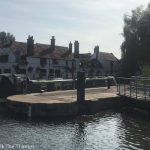 Sandford Lock 57.1
Sandford Lock 57.1The lock provides access to the pretty village of Sandford with its pubs, The Trout being the nearest, as well as the A4074 which runs between Oxford and Reading. The lock has the largest fall of any on the Thames at 2.8m.
-
 Radley Boat House 58.8
Radley Boat House 58.8Famous for its college, this is a convenient place to join the Thames Path as there is a train service to Oxford. The station is about a mile away.
-
 Abingdon 62.5
Abingdon 62.5Abingdon is a historic market town. A Benedictine abbey was founded here as far back as the 7th century although there's little left of it now. Aside from numerous shops, hotels, restaurants, bars and cafes, Abingdon's more recent claim to fame is as home to MG cars and the Old Speckled Hen beer, derived from the MG's nickname: Owld Specked 'Un.
-
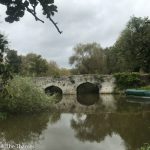 Culham Old Bridge 63.4
Culham Old Bridge 63.4It's possible to leave the Thames Path at Culham Old Bridge where the A415 from Abingdon to Culham comes close to the river. It is possible to leave a car here but spaces are limited. The old bridge crosses a stretch of water (Back Water) that runs from the Thames upstream of Abingdon and presumably is man made to divert water away from Abingdon.
-
 Culham Lock 64.7
Culham Lock 64.7Not much here except a car park. Culham railway station is halfway between here and Clifton Hampden where trains run to Oxford and Reading, but not on Sundays! Nor is the station directly accessible from the Thames Path.
-
 Clifton Hampden 67.9
Clifton Hampden 67.9The pretty village of Clifton Hampden lies on the left bank. There is a general stores here (closes at noon on weekends). On the other side of the river (right bank) lies the Barley Mow which serves meals daily. From Clifton Hampden you can walk back along the road to Culham railway station where trains run to Oxford and Reading (no service on Sundays).
-
 Days Lock/Little Wittenham 70.3
Days Lock/Little Wittenham 70.3Just past Days Lock it is possible to cross the river to Little Wittenham on the right bank from where you can climb up Wittenham Clumps, a pair of hills around 400 feet high. Hardly mountaineering but at least you get to exercise those thigh muscles. The views aren't bad either!
-
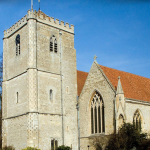 Dorchester 71.0
Dorchester 71.0Dorchester is a beautiful village and well worth the detour. It was the first capital of Wessex before Winchester. An Abbey was founded in the middle ages and the current church dates back 600 years. There are a number of pubs serving food as well as a co-op. Dorchester lies just off the Path. The distance is based on leaving the path where the Thame meets the Thames.
-
 Shillingford 72.9
Shillingford 72.9There's nothing in Shillingford (the Kingfisher pub is closed). Further downstream is Shillingford Bridge.The Shillingford Bridge Hotel overlooks the bridge and is a perfect place for afternoon tea. Note: the marker of 72.9 miles is to the bridge.
-
 Benson 73.9
Benson 73.9Benson is a busy place as a well known boating holiday company has a base here. The Waterfront Cafe serves food. And there are pubs and takeaways in the town; one of which, The Crown, offers rooms.
-
 Wallingford 75.7
Wallingford 75.7Wallingford is a busy place. There are plenty of hotels, pubs, restaurants and shops as well as a castle and a museum. It was an important stronghold during the middle ages and again during the English Civil War. The remains of the castle can still be seen. Celebrated crime writer Agatha Christie lived at Winterbrook House in Wallingford until her death in 1976. The house is in Queen Anne style and dates back to the mid-18th century. It is believed to be the model for Danesmead, Miss Marple's house in the village of St Mary's Mead.
-
 Cholsey 78.4
Cholsey 78.4Cholsey is not on the Thames Path. However, there is a road (Ferry Lane) leading to Cholsey about 1.25 miles away where there is a railway station (for Reading and Didcot Parkway), a pub and a Tesco Express.
-
 Moulsford 80.2
Moulsford 80.2The walk through Moulsford is rather disappointing as you will have to walk 0.7 miles along the busy A329 (pavement provided). Aside from the Beetle and Wedge, there are NO facilities except for a petrol station located 0.2. miles north of where the footpath meets the road.
-
 Goring & Streatley 82.4
Goring & Streatley 82.4A delightful pair of villages, Goring on the left bank and Streatley on the right bank. There are hotels, pubs, cafes and restaurants here as well as train services to Didcot Parkway and Reading. George Michael lived here from 1999 until his death in 2016.
-
 Whitchurch & Pangbourne 86.8
Whitchurch & Pangbourne 86.8Whitchurch Bridge is the other toll bridge. It's a bit more expensive than Swinford at 60p although, again, pedestrians are free. As you cross the bridge into Pangbourne you cannot but admire the idyllic scene upstream. There are 2 pubs in Whitchurch and not much else. However Pangbourne has just about everything you need: 2 hotels, restaurants, cafes, pharmacist, a co-op, and a railway station where trains can take you to Reading in one direction and Didcot Parkway or Oxford in the other.
-
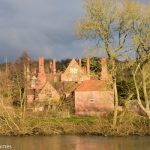 Purley on Thames 89.4
Purley on Thames 89.4Purley is just past Mapledurham Lock. Across the lock is Mapledurham House, a classic Elizabethan manor that has been handed down through the generations for hundreds of years. It is better known as the location for The Eagle Has Landed starring Michael Caine and Donald Sutherland. Purley marks the half-way point of the Thames Path.
-
 Tilehurst 90.3
Tilehurst 90.3In Purley, the Path runs through a housing estate (small hill required!) to emerge on the A329 close to Tilehurst station which is on the Reading to Didcot Parkway line. At the former Roebuck pub (where the distance is measured), the Path drops steeply back down to the river.
-
 Reading Bridge 93.6
Reading Bridge 93.6Reading is the first sizeable town since Oxford and is best approached from Reading Bridge. The railway station is one of the busiest in England with connections to just about everywhere. Despite its modern appearance it is an ancient city. Reading Abbey was founded in 1121 and it is believed Henry I, son of William the Conqueror, rests here. Overlooking the ruins is a large redbrick building. This is the former Reading Gaol where Oscar Wilde was resident and wrote his famous Ballad. Banksy has painted a mural of him escaping the gaol with a typewrite and this can be seen on the outer walls. Reading is famous for its 3 B's: biscuits, bulbs and brewing. Sadly, they have all long gone.
-
 Kennet Canal 94.5
Kennet Canal 94.5The 88 mile long Kennet to Avon Canal meets the Thames here. When completed in 1810 it provided a vital transport link as goods could be transported from London to Bristol. It fell into decline once the Great Western Railway was built. The canal provides easy access into the centre of Reading (see picture).
-
 Sonning 96.7
Sonning 96.7This village is so beautiful that even George Clooney has decided to live here. Oh, and former Prime Minister Theresa May is here too. The river splits here with rather a large island formed in the middle necessitating two bridges. There are a few cafes and restaurants but no shops.
-
 Shiplake College Boathouse 98.8
Shiplake College Boathouse 98.8At the Boat House, it's possible to leave the Path and walk past the grounds of Shiplake College to Church Lane where, conceivably, a car could be parked. Alfred Lord Tennyson was married in the church here.
-
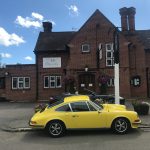 Shiplake 100.1
Shiplake 100.1Welcome to the 100 club. Shiplake is a quiet village as it's away from the road between Reading and Henley. There is a convenience store in the centre of the village opposite the Baskerville pub which also offers rooms. Importantly it has a train station being on the branch line from Twyford to Henley, where it terminates. From Twyford you can take connections to London or Reading. George Orwell once lived here.
-
 Henley 102.4
Henley 102.4Henley is a grand town, renowned for its Royal Regatta which takes place in the first week of July each year. The Regatta has been going since 1839 and teams compete from all over the world. It's also a big social event along with Ascot and Wimbledon with spectators decked in striped blazers and straw hats. It's worth seeing but you might just breathe a sigh of relief when you've gone past the crowds.
-
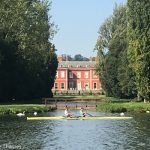 Remenham 103.6
Remenham 103.6The tiny village of Remenham is accessible by road and therefore makes a convenient break point. There is a small car park here. Directly across the river is Fawley Court. Together with Mapledurham House and Hardwick House it is believed to be the inspiration for Toad Hall in Kenneth Grahame's Wind in the Willows.
-
 Hambleden 104.3
Hambleden 104.3At Hambleden Lock it is possible to leave the Path by crossing through the lock gates (when closed!) and across the river via a footbridge
-
 Aston 105.4
Aston 105.4Aston is rather a remote village nestling on a small hill overlooking a bend in the river. The Flower Pot Hotel offers rooms.
-
 Hurley 108.7
Hurley 108.7Overlooked by neighbouring Henley this village has two pubs, one of which offers rooms, a campsite and a car park.
-
 Marlow 111.0
Marlow 111.0Another grand town with a magnificent suspension bridge. There are shops, pubs and hotels aplenty. The town has enjoyed a latter notoriety as histing the Marlow Murder Club, a novel that became a TV series. Not the only literary connection: Mary Shelley (Frankenstein) lived here.
-
 Bourne End 113.9
Bourne End 113.9Bourne End marks the turning point of an enormous loop that has been followed ever since Reading. The loop from Reading to Windsor is 32 miles but only 15 miles as the crow flies. Never mind. It's all downhill now! There are plenty of facilities in Bourne End including a railway station which is on the Maidenhead to Marlow branch line. From Maidenhead you can connect to Reading or London.
-
 Cookham 115.3
Cookham 115.3Cookham is one of the prettiest villages on the Thames. The main village is just over half a mile away where there are shops and a railway station that can take you to Maidenhead. Otherwise you can enjoy refreshments at Bel and the Dragon where you can also get a room for the night. Drop in the Stanley Spencer Gallery. Spencer was a native of Cookham and many of his paintings reflect local scenes.
-
 Maidenhead 118.6
Maidenhead 118.6The town of Maidenhead lies 3/4 of a mile to the west of the river and is therefore usually bypassed. There's no reason to visit Maidenhead other than for food supplies or for transportation - the railway station providing a regular train service into London and out to Reading and beyond. The mileage is taken at the bridge.
-
 Dorney/Bray Marina 121.0
Dorney/Bray Marina 121.0The Summerleaze footbridge takes you across the river to the marina at Bray and a car park. In the opposite direction a path will take you to beautiful Dorney Court, a Tudor Manor House and latterly a popular film set (pictured left). Sliding Doors anyone?
-
 Dorney Lake 122.8
Dorney Lake 122.8To your left is Dorney Lake, owned by Eton College and used in the 2012 Olympics. You used to be able to walk through to it but this stopped during COVID and the gate has sadly never re-opened. There's a car park at Boveney a few yards further on.
-
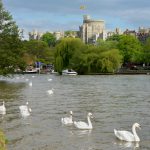 Eton and Windsor 125.1
Eton and Windsor 125.1It would be a shame if you walked through Royal Windsor without stopping. Aside from a supply of hotels and eateries, there is much to see. The castle towers over the town. But spare a thought for Eton, a stone's throw away on the other side of the river. Walk a half mile along the High Street and you will arrive at Eton College which has educated 20 former British Prime Ministers. The school is a collection of buildings on public roads. Don't be surprised to see boys crossing the road in their tailcoats.
-
 Datchet 127.2
Datchet 127.2Considering how close Datchet is to the busy M4, it is a surprisingly quiet village. There are shops, restaurants and a train station which runs to Windsor in one direction and London Waterloo in the other.
-
 Albert Bridge, Old Windsor 128.3
Albert Bridge, Old Windsor 128.3The Albert Bridge allows the B3021 between Datchet and Old Windsor to cross the Thames. It provides the Thames Path walker the shortest route to Old Windsor, although a longer but more traffic free route is by the moorings next to Old Windsor church. A royal settlement existed here from probably the 9th century until it was moved to the more strategic location of Windsor with its hill top. It's a good 0.5 mile detour into Old Windsor which has shops and refreshments. It's not particularly quaint so, unless you are in dire need, I would soldier on.
-
 Bells of Ouzeley 130.0
Bells of Ouzeley 130.0The Path meets the road after passing some moorings where you will find The Bells of Ouzeley., a pub that's, frankly, a little in need of some TLC but is first port of call for a long while if you have not detoured to Old Windsor. If you park a car, you need to log in at reception or you may face a hefty fine. The Path by the moorings is inclined to flooding - see picture left.
-
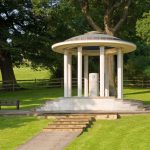 Runnymede 130.5
Runnymede 130.5Who knows where exactly the Magna Carta was signed? We know it was somewhere around here. The fact that there are nearby memorials to JFK and the RAF demonstrates that. For now, let us wallow in the history that surrounds us....somewhere?
-
 Staines 133.1
Staines 133.1Staines is somewhat of a concrete jungle with modern offices and retail parks. Despite its modern appearance, Staines is very old indeed being an important river crossing in Roman times. Staines is the first town you arrive at within the M25, the London Orbital. There is a railway station on the line from London Waterloo and both Windsor and Reading, the line forking at Staines.
-
 Laleham 135.6
Laleham 135.6The village of Laleham has buses, a pub and a shop as well as car parks. Shortly before reaching Laleham is Penton Hook Lock (pictured left). Here the natural Thames makes a very sharp meander which the lock cuts through. Think of a head with the lock being the neck. The head is Penton Hook Island and it is possible to cross the lock and access the island which has its own riverside trail. The island is home to herons and water voles.
-
 Chertsey Bridge 137.1
Chertsey Bridge 137.1Annoyingly Chertsey lies about a mile west of the river so, unless you are lucky enough to stay at the Bridge, you will need to take a bit of a walk along Bridge Road if you need lodgings, shops or transport. The station has trains running upstream to Staines and downstream to Weybridge and Walton-on-Thames.
-
 Shepperton Landing 139.0
Shepperton Landing 139.0The Path crosses to the other side of the river here. And yet there is no path. Help is by a small motor boat which must be called for by ringing a bell. It costs £3.30 per person. In bad weather the ferry service may not operate. An official Thames Path left bank alternative must be followed. This is far inferior so should be avoided unless absolutely necessary.
-
 Walton 140.3
Walton 140.3Walton lies to the right as you walk downstream and, unless you are in search of refreshment or transport, there's no reason to stop. Aside from being the birthplace of Julie Andrews, there's not much to note. The bridge was built in 2013 and must be the newest bridge on the river. It is the sixth in a long succession of bridges, one of which was painted by Canaletto.
-
 Sunbury Lock 142.0
Sunbury Lock 142.0At Sunbury Lock you will see the town of Sunbury beguiling to you with pubs, restaurants and cafes. Unfortunately there's no way to get across so you must continue past the gas works and the water treatment facility in the direction of Hampton. There is, however, a nearby hotel. The Weir sits right on the river and only accessible by foot. Rooms overlooking the river are available.
-
 Hampton Court 145.1
Hampton Court 145.1Hampton Court is full of pubs and restaurants so you will not go malnourished here. Hampton Court station sits on the end of a branch line that leads to London Waterloo. But the main reason to stop here is to see the Palace. Hampton Court Palace was built by Cardinal Wolsey during the reign of Henry VIII. He gave it to Henry in 1529 in an effort to stay in his favour having failed to get the Pope to grant an annulment for his marriage to Catherine of Aragon. Wolsey died a year later. The Palace was one of Henry’s favourites and still belongs to the Crown. The Palace, with its Great Hall, Tudor kitchens and extensive gardens and maze is well worth visiting.
-
 Kingston upon Thames 148.1
Kingston upon Thames 148.1Kingston (or Kings Town) was the coronation site for Saxon kings. Now it’s a modern commercial centre. A train station takes you downstream to Richmond. Hampton Wick is across the river. This was the starting point for Jerome K Jerome's journey in Three Men In A Boat.
-
 Teddington 149.7
Teddington 149.7Teddington Lock marks the start of the tidal Thames. Downstream from here the Port of London Authority takes charge. The river can be crossed here to reach Teddington on the left bank where a more "urban" Thames Path can be followed all the way to Greenwich where it rejoins the path on the right bank.
-
 Ham House Ferry/Twickenham 151.4
Ham House Ferry/Twickenham 151.4If walking on the right bank, half way between Kingston and Richmond lies Ham House. Built in 1610, it was one of the grandest houses in Stuart times. The house is now owned by the National Trust. There is also a ferry terminal which runs back and forth to Twickenham. It's an on-demand service so you just have to "wait and wave". At Twickenham you can enjoy rugby, beer, Turner's house, and the delightful Marble Hill House.
-
 Richmond 152.5
Richmond 152.5Richmond is a comparatively new town having been founded by Henry VII in 1501 when he built Richmond Palace, named after Richmond in North Yorkshire. Richmond Lock is the last (or first) of the 45 locks on the Thames. Richmond is the first tube stop as you walk downstream. From here on, transport is straightforward.
-
 Richmond Lock & Isleworth 153.1
Richmond Lock & Isleworth 153.1Assuming you are on the right bank, you can cross the river at Richmond Lock to walk through the lovely old town of Isleworth. Richmond Lock is the last lock on the River Thames. Isleworth is an old village where the River Brent meets the Thames. "Old" Isleworth is virtually unchanged for 150 years with Georgian and Victorian houses lining the river front. Isleworth has the feel of an old fishing village.
-
 Kew Bridge 155.5
Kew Bridge 155.5Kew Bridge separates the lovely village of Kew on the right bank from the less attractive Brentford on the left bank. The main attraction here is the Royal Botanic Gardens, a complex of 326 acres filled with one of the most diverse collection of plants in the world . Another place to visit from Kew is Strand on the Green (pictured). It's on the left bank as you head downstream from Kew. It's full of 18th century houses and pubs. You can always take the left bank for this section of the river and cross back over at the next bridge, Chiswick Bridge (156.7)
-
 Barnes Bridge 157.6
Barnes Bridge 157.6Barnes Bridge is so much more than a bridge. It's also a popular residential part of Barnes, which occupies the right bank of the Thames for the next 2-3 miles. A train station, pubs, restaurants and shops can be found here. The bridge, which is Grade 2 listed, is for rail and foot: no cars.
-
 Hammersmith Bridge 159.3
Hammersmith Bridge 159.3Hammersmith Bridge connects Hammersmith, on the left bank, to Barnes, on the right bank. Hammersmith is a busy commercial centre with good rail and tube connections. By contrast, Barnes is a quiet upmarket residential village. The two could not be more different. The bridge, which has survived two IRA attacks, is one of the most beautiful on the Thames but is currently undergoing major structural renovation and is therefore closed but open to pedestrians and cyclists.
-
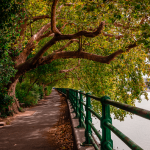 Putney Bridge 161.0
Putney Bridge 161.0End point for the Boat Race, the bridge connects Putney on the right bank with Fulham on the left. When walking from Hammersmith it’s a good idea to stay on the left bank as you pass directly by Craven Cottage, home to Fulham Football Club, Bishops Park and Fulham Palace, the former home of the Bishop of London, and you can see a glorious line of London Plane trees.
-
 Wandsworth Bridge 162.6
Wandsworth Bridge 162.6Wandsworth Bridge is a road bridge linking the edge of Fulham on the left bank with Wandsworth on the right. Wandsworth has plenty of facilities: pubs, restaurants, shops and transport. It is named after the River Wandle, which flows into the Thames just upstream from the bridge. Wandsworth was mentioned in the hugely-successful film Love Actually when Hugh Grant's assistant lives in the "dodgy end" of Wandsworth. We're not sure exactly where the dodgy end is but presumably it's somewhere near the prison, which has housed notables including Oscar Wilde, Ronnie Biggs, Reg Kray and Rolf Harris (in order of appearance).
-
 Battersea Bridge 164.1
Battersea Bridge 164.1Battersea Bridge connects Battersea, on the right bank, to Chelsea, on the left bank. Battersea is an upcoming area with a lot of housing development going on. The nearby church of St Mary's (pictured) was painted by Turner. And William Blake was married there. Battersea has a lovely park, which you will walk though if on the right bank.
-
 Albert Bridge 164.4
Albert Bridge 164.4One of the loveliest bridges on the London Thames, it has been a favourite location shoot for filmmakers. Chelsea lies on the left bank where Cheyne Walk (pictured)has been home to the rich and famous for many years: from Vaughan Williams to Mick Jagger; and from Bram Stoker to Ken Follett.
-
 Chelsea Bridge 165.1
Chelsea Bridge 165.1The name can be confusing because you'll find it dominated by the revitalised Battersea Power Station and yet Battersea Bridge is two bridges further upstream. But it does border the northern edge of Battersea Park.
-
 Vauxhall Bridge 166.7
Vauxhall Bridge 166.7This bridge, opened in 1906, carries road traffic from Vauxhall, on the right bank, to Pimlico and Millbank on the left. Vauxhall is an area of recently-built high rise blocks - commercial and residential. On the right bank, and close to the bridge, are the headquarters of MI5 which many will be familiar with from watching recent James Bond films.
-
 Lambeth Bridge 167.3
Lambeth Bridge 167.3Connects Lambeth Palace, home of the Archbishop of Canterbury, with Millbank. It's distinctive red livery is to remind us that the House of Lords is at this end of the Houses of Parliament.
-
 Westminster Bridge 167.8
Westminster Bridge 167.8Who cannot be moved at the sight of the Palace of Westminster on the other side of the river? This is why it's recommended to walk on the right bank. But cross the bridge to spend some time in Westminster Abbey. Don't forget to come back to the right bank. Plenty more spectacular views downstream.
-
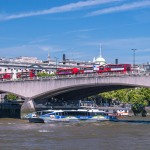 Waterloo Bridge 168.3
Waterloo Bridge 168.3This bridge was designed by Sir Giles Gilbert Scott who also designed Battersea Power Station and a few red telephone boxes. His grandfather, George, designed the bridge at Clifton Hampden as well as Reading Gaol.
-
 Blackfriars Bridge 168.8
Blackfriars Bridge 168.8Named after a nearby Dominican priory, this bridge became famous in 1982 when Roberto Calvi, "God's Banker", was found hanging from one of the arches, believed to have been murdered by the mafia.
-
 Southwark Bridge 169.2
Southwark Bridge 169.2About halfway between Westminster and Tower Bridges, Southwark Bridge is right in the heart of central London. St Paul's Cathedral and the skyscrapers of the city of London lie across the water on the left bank. Southwark has its own identity with Borough Market offering trendy independent food shops, the Tate Modern offering an unrivalled collection of modern art, and the Globe, a recreation of an Elizabethan theatre, performing non-stop Shakespeare.
-
 London Bridge 169.6
London Bridge 169.6Connecting Southwark Cathedral with the city of London, this is the approximate site of a succession of wooden bridges built here since Roman times, all of which fell down. A stone bridge was built in the 12th century which, until 1750, this was the only bridge in London. The current bridge has been here since 1973.
-
 Tower Bridge 170.2
Tower Bridge 170.2Approaching upstream the iconic Tower Bridge, you cannot help but feel you have arrived in central London. From downstream the effect is no less impressive. That the bridge is guarded by the warship, HMS Belfast and the Tower of London only makes it more dramatic.
-
 Rotherhithe & Wapping 171.3
Rotherhithe & Wapping 171.3Here the underground connects both sides of the river with Wapping on the left bank and Rotherhithe on the right. Both banks have evidence of their historic ties to shipping. Even the pubs have nautical themes: Captain Kidd in Wapping stands near Execution Dock where the pirate, Wiiliam Kidd, was executed in 1701. The Mayflower, Rotherhithe, was named after the Pilgrim Father's ship, which was moored nearby. The underground uses the Thames Tunnel, the first ever tunnel to be built under a navigable river. It was built by Marc Brunel and his son, Isambard. The Brunel Museum lies opposite the Mayflower.
-
 Canary Wharf Pier 173.1
Canary Wharf Pier 173.1Occupying the left bank, just 30 years ago this was a wasteland. It's transformation as a financial centre is remarkable. Your rucksack might feel a little out of place amongst the briefcases.
-
 Greenwich 175.4
Greenwich 175.4The final stopping point, Greenwich has so much to offer. Greenwich was the site of a Royal Palace. It was knocked down by Charles II in 1660 to make way for a Royal Naval College, a magnificent building designed by Sir Christopher Wren, and still standing. The Navy gave up the site in 1998 and the buildings are now used for a variety of purposes including the National Maritime Museum and the University of Greenwich. Also here is the Cutty Sark, a clipper that brought the freshest tea from India. And, of course, the Royal Observatory which gives its name to our time zone and the meridian
-
 North Greenwich 178.0
North Greenwich 178.0Having successfully navigated the diversions around the various building sites of North Greenwich its nice to find yourself on Olympian Way with what is now an uninterrupted path to the Thames Barrier which is now finally visible. Before setting off, you can take the Emirates skyline to the Royal Docks on the other side. Or, even more adventurous, climb to the top of the O2 Arena.
-
 Thames Barrier 179.6
Thames Barrier 179.6Despite the rather unattractive surroundings the Thames Barrier is very impressive. Built in 1982 at a cost of £534m, it is designed to prevent rising sea levels from flooding the Thames. It is generally used 2-3 times per year in addition to an annual full tide test closure. This used to be the end of the Thames Path and so has lots of plaques and markings including a mural depicting each of the towns along the way and their height above sea level.
-
 Woolwich 180.8
Woolwich 180.8The new end of the Thames Path. Why? Because here it links with the England Coastal Path which crosses the Thames at Woolwich Ferry, a free (yes, really!) ferry service for passengers and even cars. Which means the official end is at the ferry. But don't stop there or you'll be disappointed. Walk a little further to Woolwich Arsenal and you'll find a district steeped in history. For this is where the army assembled and stored their weapons. They even had a football team that subsequently moved to north London. Woolwich has three main line stations and two ferry points. So no better place to end a walk!
Ready to book?

